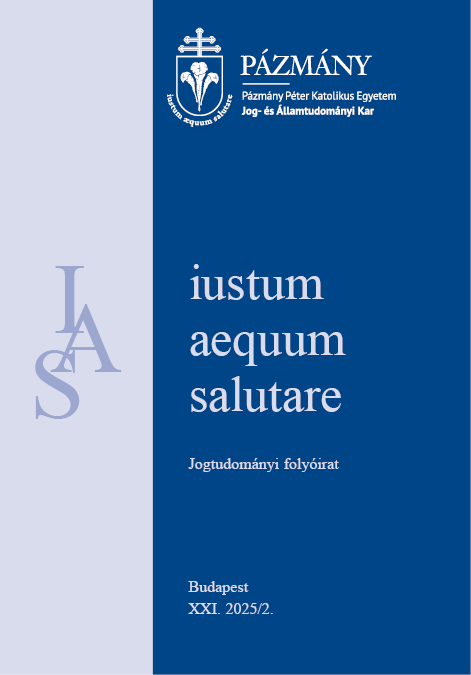Some regulatory trends and european approaches in the fight against the online sexual exploitation of children
Abstract
The online sexual exploitation of children is one of the most severe social and legal challenges of our time. The expansion of online platforms and the explosive development of technological innovations have opened new dimensions for committing these crimes. In response to the problem, European regulatory trends and domestic solutions are continuously evolving.
The forms and conceptual elements of crimes against children are changing alongside technological advancements, requiring us to address the social and legal challenges posed by new trends. Today, the spread of artificial intelligence-generated content represents a newly emerging issue, the regulation of which is spreading in many European countries. As a result, Hungary and many other countries are increasingly prioritizing the fight against online child sexual exploitation.
In this new environment, the European Union is also under continuous pressure to act, necessitating the expansion of its international cooperation-based system. An important milestone in this process is the effective involvement of online service providers in monitoring the dissemination and consumption of online content. This is currently embodied in the draft of the so-called CSA Regulation. However, the adoption of this draft raises several privacy and efficiency concerns that are still awaiting resolution.
References
Balla, Boróka – Bartók, Zita – Csalár, Dorina: A gyermekvédelem és a tartalomszabályozás új útjai az interneten. In Media Res, 2023/1. https://doi.org/10.59851/imr.12.1.8
Council of Europe Convention on the Protection of Children against Sexual Exploitation and Sexual Abuse (CETS No. 201). Lanzarote, Council of Europe, 25.X.2017. https://tinyurl.com/52hhnr99
Deconick, Carl: EU ‘chat-control’ plan goes back to drawing board. Brussels Signal, 20 June 2024. https://tinyurl.com/yyhwmauz
Dornfeld, László: ICTs and Sexual Exploitation of Children in Europe. In: Khosrow-Pour Mehdi (szerk.): Encyclopedia of Criminal Activities and the Deep Web. Hershey (PA), IGI Global, 2020. https://doi.org/10.4018/978-1-5225-9715-5.ch038
EUROPOL: Child sexual exploitation. https://www.europol.europa.eu/crime-areas/child-sexual-exploitation
Finkelhor, David: Child sexual abuse: New treatment and research. New York, Free Press, 1984.
Global CSAM Legislative Overview – An overview of national CSAM legislations in INHOPE Member Countries and the Lanzarote Convention State Parties. INHOPE, 2024. https://tinyurl.com/4h45695p
Global CSAM Legislative Overview. Executive Summary. INHOPE, 2024. https://tinyurl.com/559wfe7r
Holt, Thomas J. – Bossler, Adam M. – Seigfried-Spellar, Katheryn C.: Cybercrime and Digital Forensics: An Introduction. 2th edition. London, Routledge, 2017. https://doi.org/10.4324/9781315296975
INHOPE feedback on the EC proposed regulation laying down rules to prevent and combat child sexual abuse. INHOPE, 2022. https://tinyurl.com/35rce9va
Is this the most criticised draft EU law of all time? EDRi, August 29, 2023. https://edri.org/our-work/most-criticised-eu-law-of-all-time/
Kirwan, Grainne – Power, Andrew: Cybercrime: The Psychology of Online Offenders. Cambridge, Cambridge University Press, 2013. https://doi.org/10.1017/CBO9780511843846
Krone, Tony: Typology of online child pornography offending. Trends and Issues in Crime and Criminal Justice, No 279., 2004.
Lanzarote Committee: Opinion of the Lanzarote Committee on child sexually suggestive or explicit images and/or videos generated, shared and received by children. Council of Europe, 6 June 2019. https://tinyurl.com/hvnwe39c
Lavorgna, Anita: Organized Crime and Cybercrime. In: Thomas J. Holt – Adam M. Bossler (szerk.): The Palgrave Handbook of International Cybercrime and Cyberdeviance. Cham, Palgrave Macmillan, 2020. https://doi.org/10.1177/0022427897034004005
Leaked opinion of the Commission sets off alarm bells for mass surveillance of private communications. EDRi, March 23, 2022. https://tinyurl.com/2phchkak
Legislative Train 12.2024. https://tinyurl.com/382kpadd
Leukfeldt, Rutger – Jansen, Jurjen – Stol, Wouter P.: Child pornography, the Internet and juvenile suspects, Journal of Social Welfare and Family Law, Vol. 36., No. 1. (2014) https://doi.org/10.1080/09649069.2013.851178
Leukfeldt, Rutger – Stol, Wouter (szerk.): Cyber Safety: An Introduction. Eleven International Publishing, 2012.
National Center for Missing & Exploited Children: Online Enticement. https://www.missingkids.org/theissues/onlineenticement
Némedi, Márk: Változások a gyermekpornográfia szabályozásában Magyarországon és az Európai Unióban. Legal Forum Publications, 2016.
O'Malley, Roberta Liggett: Exploring Online Sextortion Offenses: Ruses, Demands, and Motivations. Sexual Assault Report, Vol. 22., No. 4. (2019)
Parti, Katalin: Gyermekpornográfia az interneten. Miskolc, Bíbor, 2009.
Stellungnahme des Bundesbeauftragten für den Datenschutz und die Informationsfreiheit zur öffentlichen Anhörung des Ausschusses für Digitales des Deutschen Bundestages am Mittwoch, 1. März 2023, 14:00 bis 16:00 Uhr zum Thema „Chatkontrolle“. https://tinyurl.com/mvy9zuke
Towards a global indicator on unidentified victims in child sexual exploitation material: Technical Report. ECPAT International, Bangkok, 2018. https://tinyurl.com/yk24s3dx
Transparency Reporting on Child Sexual Exploitation and Abuse Online. OECD, September 2023. https://tinyurl.com/2s4xyx44
Wetboek van Strafrecht, Artikel 252. Overheid.nl. https://tinyurl.com/49cwjstm
Wolak, Janis – Finkelhor, David – Mitchell, Kimberly: Internet-initiated sex crimes against minors: Implications for prevention based on findings from a national study. Journal of Adolescent Health, Vol. 35., 2004. https://www.jahonline.org/article/S1054-139X(04)00171-5/fulltext
Copyright (c) 2025 Árpád Varga

This work is licensed under a Creative Commons Attribution 4.0 International License.


